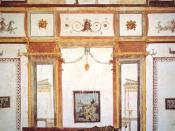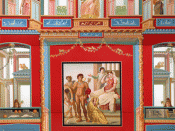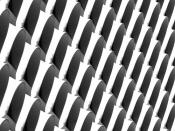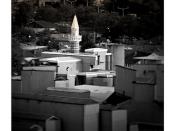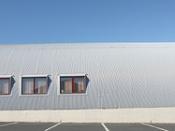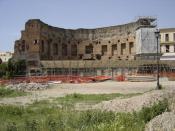Four Styles of Roman Wall Painting
The wall paintings evolved from around 2nd BC. Romans created these extravaganza works to emphasise their wealth. The evidence for the techniques used is described by Vitruvius' in De Architectura. He noted that wall paintings were interior wall designs as frescoes, which were executed using damp plaster (lime and sand mixed together). There must have been at least several layers of this plaster, where the top layers were burnished with marble powder to make the surface smooth and glittering. Then on this medium the pigments of primary colours were applied quickly while it was still wet. The colour black was drawn from carbon of burned brushwood; yellow was obtained from mines or from heated white led; baked mixture of sand and copper produced colour blue; red was obtained from red ochre or cinnabar; and the most precious colour purple was obtained from sea whelks.
The essential tools used for plastering the walls were wooden float and trowel blades. Many wall paintings are very well preserved because as plaster dries, water evaporates and plaster absorbs carbonic acid gas (from air) which forms a protective skin of crystalline carbonate of lime. The roman wall paintings were inspired by Greek and Hellenistic paintings and architecture.�
The wall paintings were classified into four 'styles' by German archaeologist August Mau (1840-1909). He did not consider individual elements of paintings but rather focused on decorative composition and patterns and how they might be grouped into certain period 'styles'. So these styles marked the shifting point in the chronology of painting from 2nd century BC to the final eruption of Mount Vesuvius in Pompeii in 79 CE as there are the most wall paintings that have survived. The 'styles' were identified as follows: the 1st 'style' is called Incrustation style (2nd - 1st BC); the 2nd was Architectural style (c. 100- 15 BC); the 3rd was Ornate style (c.20 BC - c.20 AD); and the 4th was Intricate style (from c. 50 CE).�
The first style is most distinctive style from all. Using this style, the wall was painted and moulded from stucco with the replication of various architectural elements such as masonry bricks, suspended alabaster discs, 'wooden' beams, mouldings of dentils and etc. The figures did not give much of the importance to overall painting. The colours used were very bright such as yellow, red, green or even 'marbled effect' in order to display the splendour of the buildings. The wall was usually divided into three horizontal panels. Probably the earliest example can be found in the diagram of 'tablinum' (south west wall) the house of Livia (c. 30 BC) in Rome. Here we can clearly see the division of wall by two vertical lines into three major sections, which are further divided into small sections, appearing as masonry blocks. The other wall painting appears in Samnite house, in Herculaneum during c.2nd BC. This elaborate marbled panel appears as wall of bricks with glittering affects, which completely fits into the definition of Incrustation style. This style was mostly influenced by Greek art with representing materials of building and the figure drawing was influenced by Hellenistic wall paintings.
The replacement of first style occurred around 80 BC after defeat in the Social War. Here the Architectural style emerged, with the emphasis on the imitation of architectural forms to evoke a more spectacular type of architecture. Instead of using details based on stucco, there was the use of flat plaster on which projection and recession were emphasised by the use of shading and perspective. The common features in this style are use of Ionic columns or stage platforms. But still these decorations make the wall to appear sort of 'closed in'. The architectural style is evident in the house of the Griffins on the Palatine Hill in Rome. There was found the geometrical marble affects on the walls with use of stucco like in the first style, but only here the sense of three dimensional surface is evident with the notions of optical illusions as fake columns and pillars protrude from the wall; also the use of shading and highlights combine with real lighting of the room to create the realms of fantasy. Other wall decoration of this style was found near Pompeii in the villa of the Mysteries. But here most of the features of second style are absent. There are stage-like settings: a bright red background with, still divided into panels by vertical columns, but the figures seem to be most important feature of this wall painting as they cover the columns. These divine human figures seem to be performing some kind of ritual initiated by the Greek God of wine - Dionysus. Probably, these kind of theatrical paintings were mostly influenced by Hellenistic Greek tradition.�
As we wander from second style, under the influence of Emperor Augustus (r.27 BC - 14 AD), the people were more interested in displaying the elaborated details, rather than optical effects; also realistic columns were not likable anymore, so they were replaced by reed-like pillars with foliage; so with this change the Ornate style begins. Here painters had a strict sense about symmetry of the elements around central element; the pictures themselves were kind of suspended within monochromatic frames. The vertical zones of this frame would have been decorated by geometric motifs, columns of foliage hung around candelabra (incense-burners). The use of mythological creatures in the background was relevant to this style. So there was a development of the grotesques, where vegetation combines human and animal bodies together. One example of this style is 'Villa Farnesina' (riverside villa), where the elaborate details of grotesques is clearly evident. In the kitchens or dining areas the frescoes represent the still life, for example still-life found in Herculaneum, depicts a bird and some sort of vases.
Other examples come from the House of the Vettii. Here the wall paintings comprise a single monochrome background in colours such as red, orange and blue with elaborate foliage-like details. These frame the smaller figural paintings in the centre of the wall. In one scene figures seem to be involved in daily tasks; in other it involves mythological creatures involved in some kind of ritual, background is emphasised with architectural elements. These paintings look as they were not painted straight on the wall but were hanged which gives more realism to the overall style of painting.�
The last, Intricate style is sort of a combination of all the styles, because it does not posses any distinctive feature. And yet it is most complex and extravagant style of all. It borrowed the sense of illusionism from second style; and figure painting and architectural details from third style. It involves 'large-scale narrative paintings', usually drawn from mythology. The main features of this style are the representations of opened doors and windows, balconies; also include some visionary elements of architecture. The paintings appear more realistic as painters created illusion of depth and perspective. And therefore, the paintings make rooms more open and appear wider. One of the examples reflecting this style is Domus Aurea of Cryptoporticus from Rome. This is very large room, with tall walls and oval-shaped ceiling. Here we can see the wall divided by many vertical lines, along with horizontal lines into these illusionistic areas, proceeding into a distance. Areas contain subjects such as windows, doors, balconies, sculptures of human or animal bodies. The other example is House of the Theatre in Herculaneum. This is very extravagant decoration with strong colours; there is tapestry with small human head on higher part of the panel. In the lower part there is an optical illusion of opened door with notion of foliage and other spectacular decorations. Also in the House of Vettii, there are fourth style wall paintings. Here there are depiction of mythological creatures such as cupids performing some kind of rituals; the use of contrasting colours such as pink and blue. During this style, dining rooms were decorated by still-life paintings of fishes, birds, fruits and glass vessels.�
All the painting styles have features that are distinct and some in common. The wall painting chronology evolved from creating fake masonry, the use of optical illusions to create depth to the use of mythological subjects and landscape scenes; to the more elaborate use of colour which made them to appear as panel paintings jus being hanged on the wall, because they appear as framed pictures; also the emphasis of architectural elements evolved into the grand style of painting with emphasis on architraves, pediments, pillars and ornamental human and animal sculptures. These styles of wall painting really show the daily rituals that Romans were involved in that period of time. They probably wanted to surround themselves with these beautiful ornaments to emphasise their financial success. And yet it also shows the remarkably mastered skill of the craftsman during that period.
Bibliography
Ramage, Nancy & Ramage, Andrew Roman Art: the Cambridge Illustrated History Cambridge University Press, 1991 pp.55-65 (Wall Paintings)
Steward, Peter Roman Art Greece & Rome: New Surveys in the Classics No. 34; Oxford University Press, 2004 pp. 74-92
Strong, Donald Roman Art revised by Roger Ling, 2nd edition, 1988; pp. 63-74
http://en.wikipedia.org/wiki/Pompeian_Styles
Department of Greek and Roman Art. "Roman Painting". In Timeline of Art History. New York: The Metropolitan Museum of Art, 2000-. http://www.metmuseum.org/toah/hd/ropt/hd_ropt.htm (October 2004)
� � HYPERLINK "http://en.wikipedia.org/wiki/Fresco" ��http://en.wikipedia.org/wiki/Fresco� ; � HYPERLINK "http://www.metmuseum.org/toah/hd/ropt/hd_ropt.htm" ��http://www.metmuseum.org/toah/hd/ropt/hd_ropt.htm�
� Steward Roman Art pp. 74-76 (Pompeii and Paintings)
� Strong Roman Art pp.65-68; � HYPERLINK "http://www.metmuseum.org/toah/hd/ropt/hd_ropt.htm" ��http://www.metmuseum.org/toah/hd/ropt/hd_ropt.htm�
� � HYPERLINK "http://en.wikipedia.org/wiki/Pompeian_Styles" ��http://en.wikipedia.org/wiki/Pompeian_Styles�
� Steward Roman Art pp.80-82 ( the Third and Fourth styles); � HYPERLINK "http://en.wikipedia.org/wiki/Pompeian_Styles" ��http://en.wikipedia.org/wiki/Pompeian_Styles�
